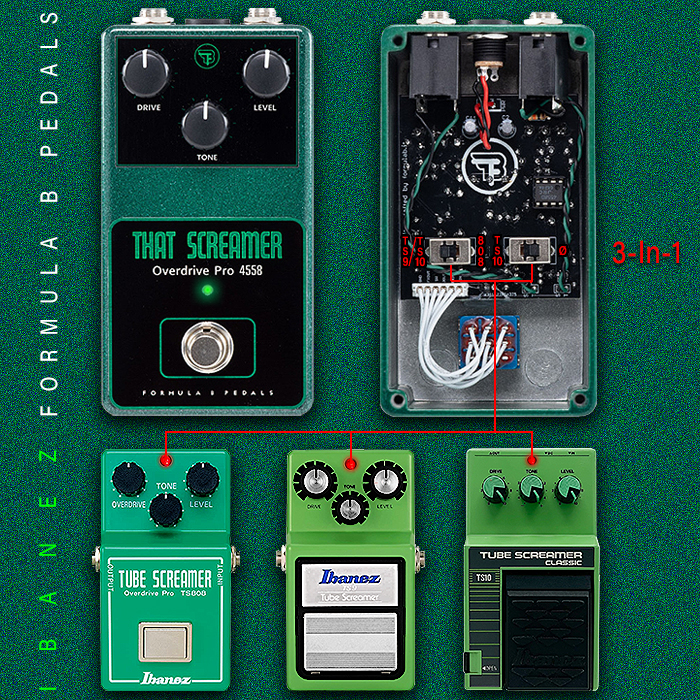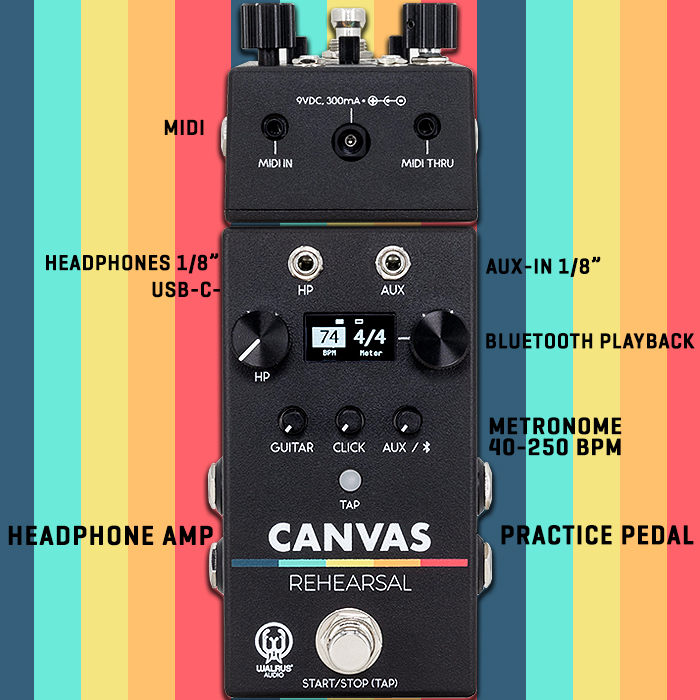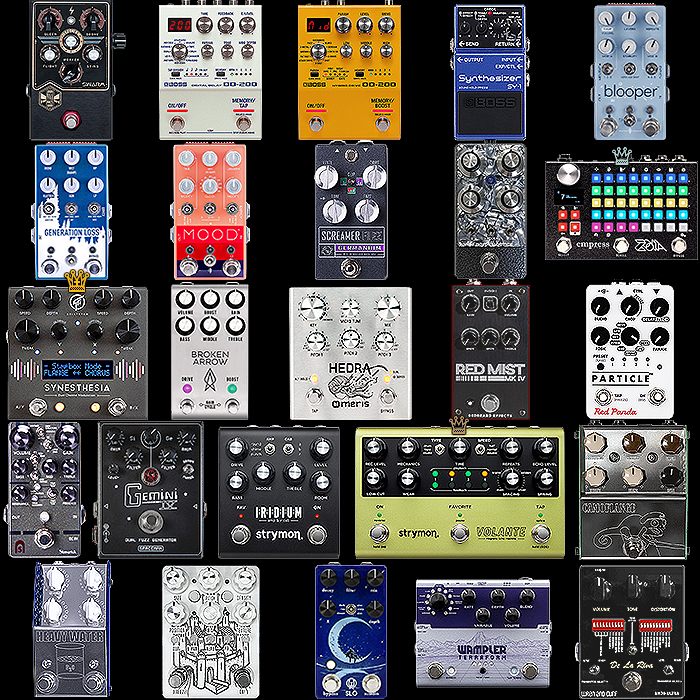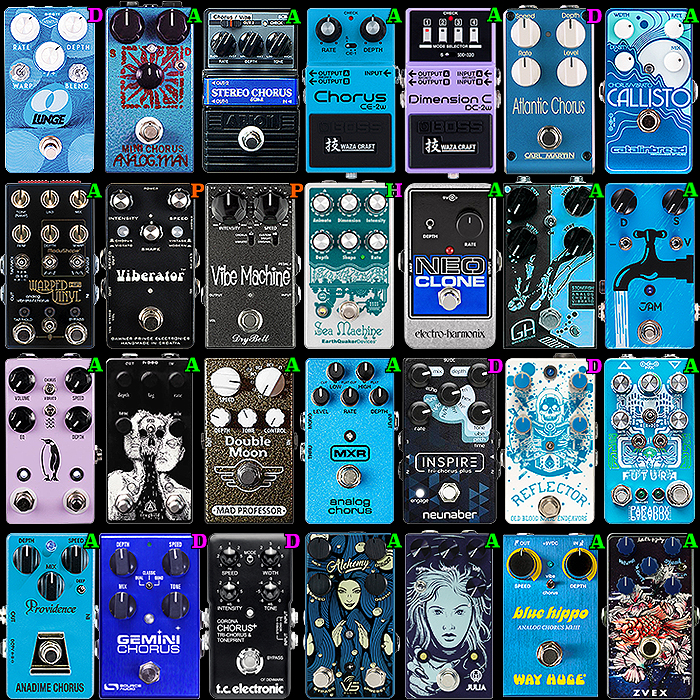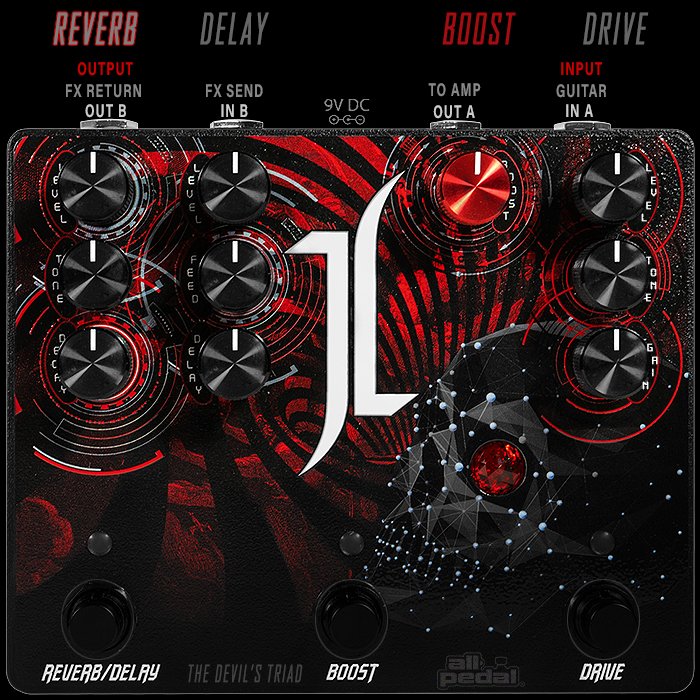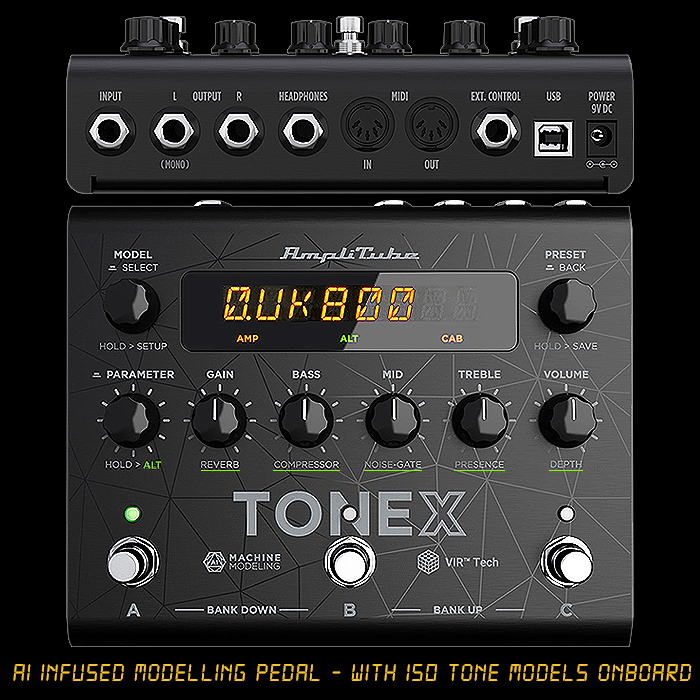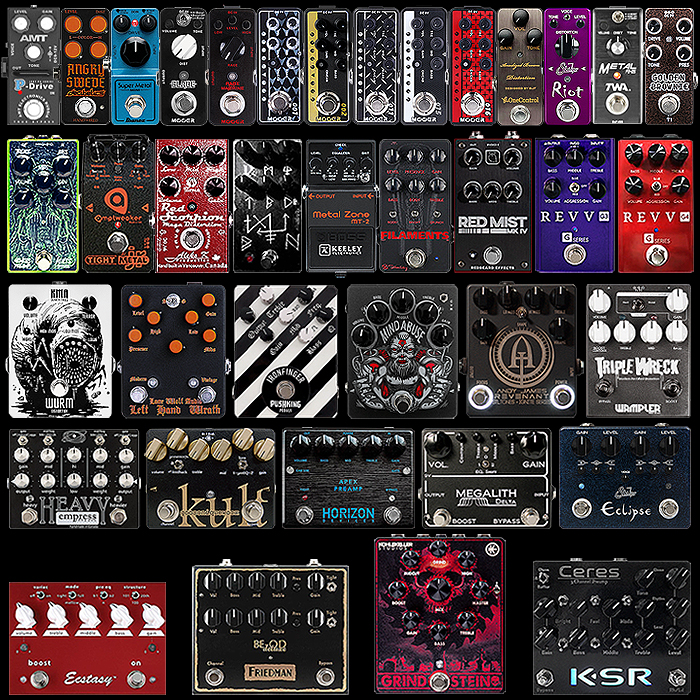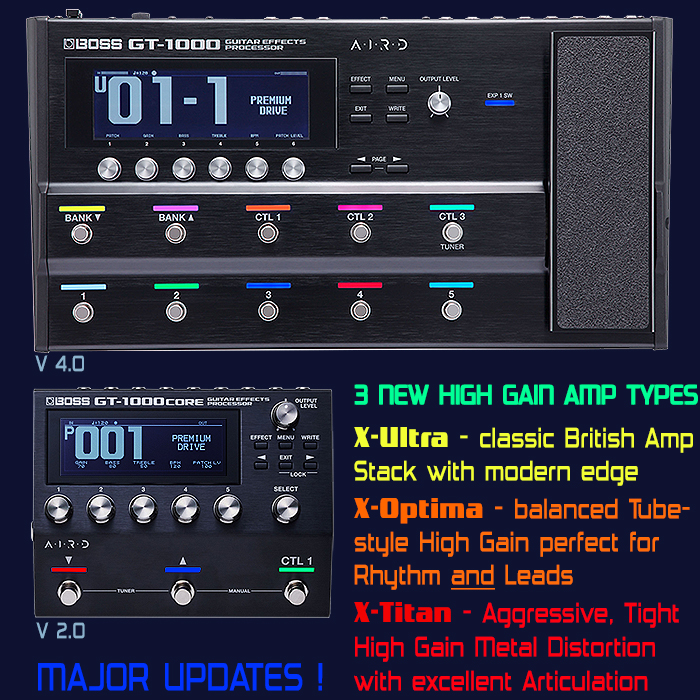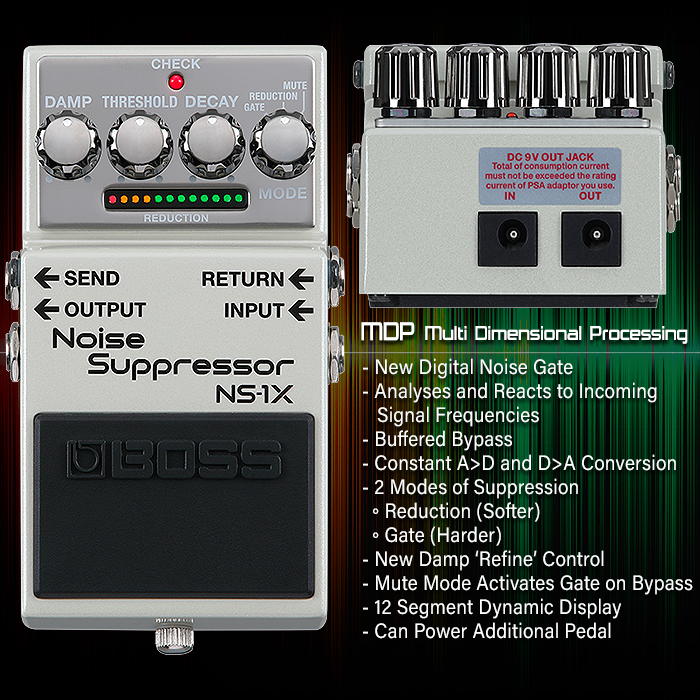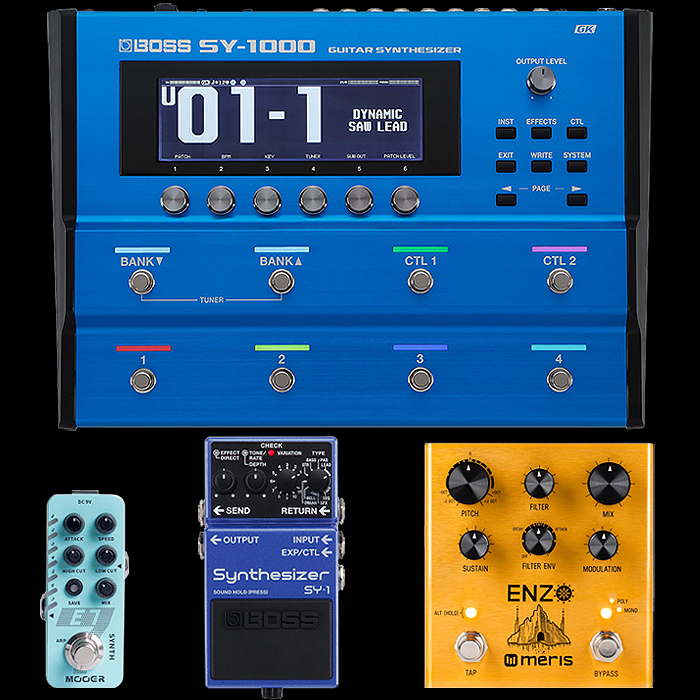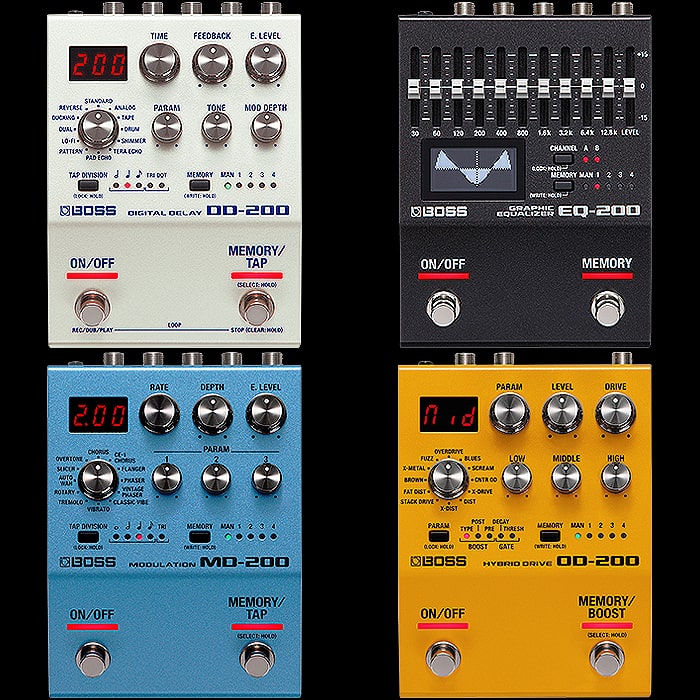Boss GT-1000 CORE In-Depth Review and Long-term Impact Report

This is one of those articles that’s been a long-time coming, and where I needed to spend a rather large chunk of time getting fully under the skin of the pedal in question - the really quite superb, but also somewhat slightly flawed Boss GT-1000 CORE Guitar Effects Processor.
I must start by stating that I came into this project with somewhat lofty expectations, and there was some degree of naivety to my beliefs as to what was contained within this pedal, and more importantly exactly how it would work at its core - and in specific within my own setup.
My intention was always primarily to use this as a complementary / supplementary Multi-FX stompbox unit - and Multi-Modulator in particular - stepping in for the GFI System Synesthesia, Empress Zoia, Boss MD-500 and Strymon Mobius - which were all previous incumbents on slot #34.
I took the GT-1000 CORE for a near replica of the original much bigger GT-1000 - but just with a lot fewer controls, inputs and outputs.
I was aware of the High Fidelity 32 Bit processing power and 24 Simultaneous effects ability, but for some reason, I had not clocked that the CORE came without the GT-1000’s Bluetooth App Connectivity, and that it contained just 2 of the 1000’s 3 Control Modes - Memory and Manual, while it was missing the ’Pedalboard’ option.
I have a lot of experience with the Eventide H9 Max, which lives on slot #38 and gets brought into action fairly regularly, but by default is set mostly to standby. This is largely how I intended to utilise the CORE.
The Challenges, Omissions and Actualities

CONTROL / PLAYBACK MODE
Somewhat contrary to my initial understanding, the CORE does not come with a default 'Stombox Mode' / 'Front of Amp Mode' as such. In fact it has no default standby/bypass mode at all. Rather the pedal is designed more as an 'always-on' unit.
There is no dry-signal pass-through either - if this unit is connected to your chain it will always be 'processing' your signal. Meaning that even with no effects active - you still have analog to digital and digital back to analog conversion.
The first thing I had to do was to create a 'Blank' patch - by doing the Write > Initialize > Write routine. Meaning I essentially 'wiped' the first User Patch - U001 - where I then had to switch off all the effects blocks within the FX Grid - and I applied instead Metronome, Tuner and PFX (FX Off) functions to the 3 core pedal Control Footswitches.
The Blank patch is thus my 'Standy' / 'Bypass' mode - and I need to page to and from said default whenever I wish to take the pedal off active duty.
SMOOTH VS SHARP / BRITTLE DEFAULT SIGNAL
With a 'Blank' patch applied, I noted that my signal chain no longer had that smooth and gooey analog warmth, but was instead rendering somewhat sharper and more brittle - I must give a shout out to Matt Knight and Mark Harley from Boss who were supremely helpful to me throughout my initial explorations.
They guided me to the Global EQ settings where they recommended I adjusted Hi and Lo Cut to 6.30kHz and 250Hz respectively. I actually use quite a lot of low-frequency content so didn't really want to shave off the Bass response, while I found setting the Hi-Cut to 8kHz worked a treat for me - and brought back that analog style warmth again.
DESELECT TO RESELECT / FOOTSWITCH ASSIGNMENT
The only part of the pedal that still causes me intermittent challenges is in the assignment of footswitch controls - which I seem to mess up somewhat on every few patches I do. I somehow manage to switch out the System controls for Patch Controls and end up having to re-assign the controls for the FS-7 Dual Footswitch - which I employ entirely as a Patch Down / Up set of switches. Mostly this works perfectly fine - but I occasionally find I have somehow disabled the FS-7 and its switching no longer works. It's fairly easily remedied, but I find the process a little clunky.
I find that you're typically best off with deselecting active / assigned functions first - i.e. switching them all to 'Off' before reassigning to your preferred settings. I'm currently not sure what I'm doing wrong on those occasions I manage to de-couple the FS-7 - I've not picked up the pattern quite yet - mostly though it's not really an issue.
LACK OF CONFIGURATOR / GLOBAL PLAYBACK DEFAULTS
I feel that the pedal should have a proper 'Stompbox Mode' option which disables all the AIRD Preamp assignments in one move. Modern computers and smartphones have superb configuration / setup screens / onscreen guides - which take you though the process of setting the device up exactly to your specific requirements.
Currently for me I have to go into every patch and disable the AIRD Preamp selections - where I feel that would be much better handled by a proper GLOBAL CONTROL / CONFIGURATOR.
The Software / Firmware here is rather in is infancy in most ways, and does not have the sophistication of modern consumer computing devices - I expect this will come eventually, but for now it's all a little manual and clunky really comparatively.
THE ACTUAL EFFECTS BLOCK GRID - ON RAILS!
As we will cover next, the core of the interface here is the circa 32 Block EFFECTS GRID. I had rather expected this to be more of an open-world / open-plan environment, when it's really quite a rigid 'on-rails' system.
This means that those 32 Effects Block have very specific purposes and assignments and very fixed limits in place - which mean a total of 3 x Dual Parallel paths - i.e. 3 nodes as such or 'Dividers' which each can have 2 Branches - Channel A/B. So you cannot just select multiple incidental parallel paths like on say a Poly Beebo - but must rely on essentially 3 parallel sets of 2 branches.
I had hoped/expected this to replace each of the 500 series boxes, but it doesn't really - as you can only actually deploy a single Reverb Block, and all the Delays are not really full-fat DD-500 variants either as only the Master Delay Block allows you to select the different character delays - the DL1-DL4 varieties are rather more simplified versions of a standard delay.
I had also wanted to produce a patch with each of the 3 Fuzz voicings - 'OCT FUZZ', '60S FUZZ' and 'MUFF FUZ' where I could switch between them using the 3 Stombox Controls. While we only have 2 Blocks which will accommodate Gain/Distortion effects - [DS1] and [DS2].
So while the architecture is very powerful in terms of the total number of 'Blocks' you can deploy at once, you can only do so in a very specific manner as we will detail next.
NAMING / CHARACTER ENTRY
This seems somewhat clunky to me - in that I seem to have to enter the label / patch title characters in reverse order - to assign names to patches. Possibly I'm doing something wrong here - but the select and enter puts the next character before rather than after the last one you last entered - which seems somewhat contrary to me.
NO BLUETOOTH
This is actually a very significant miss for me - as I'm so used to using the Bluetooth App with my Eventide H9 Max - and I hate having to drag my laptop over to the pedalboard / pedal-chain and hardwire it to the pedal every time a firmware release / update arrives. The whole Firmware Update process is unnecessarily clunky as a result.
For a pedal with as much functionality and feature set as the GT-1000 CORE - it really needs an intuitive connected App Interface to smooth out some of the rough edges.
The CORE is somewhat a lesser proposition for not having this essential feature. For me the Eventide H9 would be unusable without its Bluetooth App Interface. For the GT-1000 CORE the on-device interface is relatively decent although somewhat rudimental and 'go-fish' in places. You're not always fully aware of where you need to be making changes - but compared to the poor H-9 on-device pedal topology and interface - the CORE is rather a lot more straight-forward. I do though tend to find myself on my knees quite a lot for making adjustments - while a proper Bluetooth App would allow me to do all that standing up!
CONTROL STRIP ACCESS / SCROLLING / PAGING
I would actually really like to have some way to scroll / page through the Control Strip (5 Knob Parameter Settings) on the Playback side - so I don't need to keep entering the Effect Chain - to scroll forward and select to update individual parameters. There needs to be some way to scroll though the Active Parameters on the active display-side - for proper efficient on-the-fly adjustment! This means you could just page through the Control Strip for everything that is currently active - with an emphasis on what is assigned to the Control Footswitches. This feature set would be killer if Boss could make it happen!
OUTPUT SELECTION / CONFIGURATION
With my dual amp stereo setup I was totally confused as to which Output Selection / Setting I needed to apply - as the instructions don't really explain what to do in those circumstances. Matt and Mark pointed out that in those instances I needed to select 'Recording' for the least IR-coloured and most full-frequency-range output - which worked very well once I knew what to do!
I'm not using the CORE as an IR / Load box, and as such I'm not really concerned with the lack of XLR out - which is though one of the few advantages that the Line 6 HX Stomp has over the CORE.
INPUT SENSITIVTY
The Input Sensitivity is really what you use to tune the CORE to each of your guitars / input sources - so largely you adjust for the output level of your pickups etc. I'm largely a one-guitar player and as such I don't need to apply too many Input Sensitivity Profiles as such - it's another element though that you need to be aware of when 'Tuning' the CORE to your preferred soundstage / output.
INDIVIDUAL ASSIGNMENT / EFFECTS COVERAGE
There's a huge feature set in play here and you actually have more options in many ways than say the MD-500 and OD-200 - where the CORE mostly replaces those and then adds some extras. The CORE though does not have fully equivalency with the DD-500 or RV-500 (in fact not really fully the MD-500 either as the CORE is missing some of those algorithms) and it only has one Master Delay Block, and one Reverb Block. While with the DD-500 and RV-500 you can assign two fully fledged Character Delays or Reverbs. I personally had somehow expected to be able to cover all the Boss 200 units which this does, and all the 500 units, which this actually does not fully cover as such - i.e. no total equivalency.
I can totally understand the need for certain limitations - and while you have broader coverage of gain effects here and can apply them as Boost or Main, Parallel or Series - you cannot though include all 3 Fuzz voicings on a single patch.
I would have liked more of an open-world / open-plan grid with slightly more flexibility - but obviously that would require significantly more processing power which is already being utilised at optimal levels by the Boss engineers - particularly in the nature of 24 simultaneous Effects Blocks vs the 6 of the Line 6 Helix HX Stomp.
I still feel though that Boss needs to add in all those 'missing' algorithms pretty snappish!
FS-7 DUAL FOOTSWITCH
Based on my experience with the GFI Synesthesia and Eventide H9 - I knew I would need additional footswitches to exercise the kind of control I needed. And the Boss FS-7 seemed the most obvious candidate here for scrolling up and down through the Patches / Presets. Apart from my occasionally messing up the Control Assign parameters, the FS-7 is working out really perfectly.
The Effects Grid / Flowchart / Signal Flow

Note per the above visual that the active selected Block appears with double-outline.
I've already mentioned how the core UI element here is the EFFECTS GRID of 32 Effects Blocks - each of which has a specific function - and where the 'Law of Conservation of Mass' sort of applies - in that you cannot add or delete those Blocks - simply activate / deactivate and move them around.
There are a few Blocks that cannot be disabled as such - but the vast majority can simply be switched 'Off' if and when you don't need them.
The GRID / FLOW CHART indicates all the elements in place and in play - and for sake of our example here - I've enabled / activated every block in the chain / grid in the above visual. If disabled they would simply disappear from view and leave a blank / hole in the chain wherever that Effect Block had been placed / moved to.
Here follows a general overview per the above visual - which shows the full flow of the EFFECTS GRID :
- [PFX] = Pedal FX On/Off
- [CMP] = Compressor On/Off Footswitch Control : (6 Types)
- [EQ3] = 3rd EQ / Tone Stack, #3 of 4 : (Type Parametric or Graphic)
- [1 = Divider 1 / First Node, #1 of 3
- {Divider 1 upper / Ch.A, #1 of 2 Channels : part of 3 possible parallel pairs}
- [DS1] = Distortion 1, #1 of 2 : (Currently 35 Types, inc. 7 for Bass)
- [▲▼1] = FX Loop Insert 1, #1 of 2
- [FX1] = 1st Effect, #1 of 3 : (Currently 33 Types, inc. 6 for Bass)
- [:1:] = AIRD Preamp 1, #1 of 2 : (23 Types)
- [NS1] = Noise Suppressor 1, #1 of 2
- [EQ1] = First EQ / Tone Stack, #1 of 4
- {Divider 1 lower / Ch.B, #2 of 2 Channels : part of 3 possible parallel pairs}
[DS2] = Distortion 2, #2 of 2
[▲▼2] = FX Loop Insert 2, #2 of 2
[:2:] = AIRD Preamp 2, #2 of 2
[NS2] = Noise Suppressor 2, #2 of 2
[EQ2] = 2nd EQ / Tone Stack, #2 of 4
- 1] = Divider 1 Mixer, end of Node #1 parallel balance
- [EQ4] = 4th EQ / Tone Stack, #4 of 4
- [FV] = Foot Volume Control
- [DL1] = Delay 1, #1 of 4: (1 Type, 7 Params)
- [DL2] = Delay 2, #2 of 4
- [DL3] = Delay 3, #3 of 4
- [DL4] = Delay 4, #4 of 4
- [MDL] = Master Delay : (15 Types)
- [FX2] = 2nd Effect, #2 of 3
- [FX3] = 3rd Effect, #3 of 3
- [CHO] = Chorus : (7 Types)
- [🔁] = Looper
- [REV] = Reverb : (10 Types, inc. Tera Echo)
- [2 = Divider 2 / Second Node, #2 of 3
- 2] = Divider 2 Mixer, end of Node #2 parallel balance
- [3 = Divider 3 / Third Node, #3 of 3
- 3] = Divider 3 Mixer, end of Node #3 parallel balance
- [◘{O/LR] = Output Path Symbol
- [OUT] = Out Assignment / Simulation / IR
- [◘{S/LR] = Sub Output Path Symbol
- [SUB] = Sub Output Assignment / Simulation / IR
- [MST] = Master Control - PATCH LV | BPM | KEY | CARRYOVR | BS MODE (Bass)
Effects Grid / Effects Blocks / Flowchart Summary

Here is a brief summary / accumulation of the above individual elements - in terms of numbers :
- 5 x Delays : [DL1]-[DL4] + [MDL] Master Delay
- 4 x EQs : [EQ1]-[EQ4]
- 3 x Effects : [FX1]-[FX3]
- 3 x Parallel Path Dividers : [1-[3
- 3 x Parallel Patch Mixers : 1]-3]
- 2 x AIRD Preamps : [:1:] and [:2:]
- 2 x Distortions / Overdrives / Fuzzes : [DS1]-[DS2]
- 2 x FX Loop Inserts : [▲▼1] & [▲▼2]
- 2 x Noise Suppressors : [NS1]-[NS2]
- 1 x Chorus : [CHO]
- 1 x Compressor : [CMP]
- 1 x Foot Volume : [FV]
- 1 x Looper : [🔁]
- 1 x Master Control : [MST]
- 1 x Output : [OUT]
- 1 x Pedal Effects On/Off : [PFX]
- 1 x Reverb : [REV]
- 1 x Sub Output : [SUB]
- 5 x Fixed Blocks (Cannot switch off) - [FV] . [🔁] . [OUT] . [SUB] . [MST]
The EVH Patch

One of my earliest Patch Projects was to set up an Eddie Van Halen style patch - using the CE-1 Chorus, Flanger, and Script Phaser (FX1-FX3], as well as the Guv'nor / GUV DS Distortion voicing as the main flavour of drive. Matt and Mark from Boss recommended using the CENTA OD also as a boost - in conjunction with the Guv'nor. While you definitely also need a Noise Suppressor, and having a follow-up EQ really helps you to tweak things just right.
I set up the patch also with the Echo PX as the Master Delay, and the Plate as the Master Reverb - but had those selected as disabled largely - as I tend to use my Strymon Volante and NightSky for those purposes.
The 3 pedal footswitch assignments allow you to switch in/out the Chorus, Flanger and Phaser - which are all 'Off' by default. There's no ability to then add a Wah or Octaver as we're limited to just those 3 FX Blocks.
The rough chain makeup and order is as follows :
- ... [1 . [FX1-CHO] . [FX2-FL] . [FX3-PH] . [DS1-CENTA OD] . [DS2-GUV DS] . [NS1] . [EQ1] . 1] ... [MDL-ECHO PX] ... [REV-PLATE] ...
While I frequently swap around the DS1 and DS2 blocks for a different level of accentuation. All the essential Blocks are contained within the #1 Divider, while the Master Delay and Reverb follow on behind - albeit I mostly have those set to 'disabled'.
The setup here was really very easy, I felt I needed the EQ Block to get the texture / tonality perfect - obviously involved a fairly significant level of tweaking - but all rather easy in the end.
My next explorations will rather be more into parallel path experiments - which I'm currently just getting my head around as to how that best works on the CORE.
Final Thoughts and Recommendations
I obviously suffered a few 'teething troubles' early days with this device - which caused me some consternation for the first 3 or 4 days - before I properly got into the swing of things. I would say that I feel for sure that the control interface could be made quite a bit more intuitive - in particularly for those incidental settings. The EFFECTS GRID is pretty straight forward once you figure that out - the difficulty is really remembering all the places you need to navigate, and the sequence thereof - to affect some of the more incidental settings.
I'm largely very familiar with the device now and very comfortable with its operation - bar those very occasional lapses in Control Footswitch Assignment. Generally though the pedal very much serves its intended purpose - while I had to somewhat workshop it to get it to where I needed it to be - and there are still some aspects of it that are somewhat annoyingly clunky - but understandable really to a degree within the scope of all that this pedal is capable of.
Even though this is a somewhat 'On-Rails' device - its scope is second to none - and particularly at this size / format. I feel that this is very much a V1 style interface and we will see much improvement over the coming months and years.
Also while the CORE lags somewhat behind the HX Stomp in total effects coverage - those elements will be added to and built up for the Boss variant - until they are largely at parity. I've stated many times that I have a somewhat innate knowledge of Boss algorithms - I know how they sound and how best to tune them - and I've always had an affinity for Boss Effects - right across the board.
As a Digital Pedal this needs some significant tuning to render close to Analog levels of core texture, and there are certainly some aspects of this pedal that could be significantly improved.
There really needs to be a better flow about how you assign parameters - and how various elements of the interface are served up together - as some parts of the system are somewhat disconnected on a topology level. I certainly feel that several aspects should be fairly easily improved via software / firmware updates, while others will likely remain as known limitations.
I of course would like a dry-signal pass-through / bypass which seems somewhat unlikely - therefore at least some sort of default Global Bypass/Standby option.
I feel the lack of Bluetooth is a big miss here as that would have made everything about controlling this pedal so much easier - in particular all the myriad forthcoming firmware updates that will inevitably happen.
The Price at £599 is kind of high-ish, but largely justified in terms of what you're getting for your money - while the older / more mature HX Stomp is quite a lot less dear at the moment. I really don't know why all 500 device algorithms weren't included on the pedal?
I personally am broadly satisfied with the tones and range of functions I can achieve with the GT-1000 CORE, and while it did not exactly match expectations - it certainly performs well enough to justify its ongoing place on Slot #34 in the pedal-chain. It allows me to do most of what the Synesthesia does and so much more besides.
And because I have all my analog modulations too in my pedal-chain - I don't really need all of those in the CORE - I still feel Boss needs to add quite a few more algorithms though - including an Harmonic Tremolo - and Pad Echo and Lo-Fi Delay from the DD-200. And where is the Dimension C/D ?? I feel that is one area which Boss keeps making a mis-step in - there were too many misses on the MD-200 - where overall the Wampler Terraform and GFI Synesthesia are much more compelling. Boss sometimes forgets that every pedal in its range needs to be the very best it can be - not to deliberately hold-back certain algorithms for certain devices. This is supposed to be the perfect all-rounder pedal in this format - but it still lacks equivalency with its forebears, and what is already out there in the marketplace. Superior processing power alone cannot be the major incentive. A more holistic approach is needed here.
I'm pretty sure Boss will rise to the occasion and get this device to a level I'm 99.99% satisfied with. For now his is very much a V1 / Work-in-Progress, and Boss is playing catch-up here in several respects.
Boss haven't really been champions in interface design - in fact some of their interfaces are decidedly clunky (RC-10R!). I feel they need a little more experience and expertise in the area of GUI's - possibly they need to hire one or two more staff which have those high level software-architecture abilities.
With complex devices such as this - the overall User Experience is everything - and judging by how often I get caught out as such - I feel three is still quite a bit of room for improvement.
You will need to decided for yourself at what level of device maturity you come onboard - the same is very much true of devices like the Empress Zoia and Poly Beebo / Digit - which are still very much early days - and somewhat raw.
More sophistication will come through periodically - and I'm quite satisfied with being onboard the CORE from the start. I feel Boss can do a lot here to catch up and eclipse its competitors - while the paradigm is ever shifting - and the Neural DSP Quad Cortex is currently very much the new benchmark for this particular sector while that device is significantly larger and 3 times the cost of this CORE.
I feel the competition will be between the CORE and the HX Stomp - and it largely depends what you're used to - I've forever been Boss-centric - I have intimate knowledge of most of those algorithms, how they work and sound and how to get the best out of them. Others will be more into the Line 6 way of doing things. The Line 6 has more algorithms and a significant price advantage currently - while at its Core the Boss is the superior technology.
Superior does not always translate to better though - and this market is still very much about usability / ease of use - and both devices have a significant distance to travel to reach the level of where numerous consumer computing devices already operate.
I certainly want to see more suggestible configuration here - more easy on-the-fly adjustment etc. I feel Boss has a real advantage with its 5-knob Control Strip - it just needs to figure out how to give you quicker and easier access to tweaking live sounds - which is still somewhat clunky at the moment.
I also feel that Bluetooth really should be the default route for Apps nowadays and Firmware Updates - as mentioned it has been essential for my enjoyment of the Eventide H9 - as I would never have bought that device had it not had the Bluetooth connectivity. We know we're going to be making regular firmware updates here and the old hard-wired cable method really needs to be relegated to the past now!
The Boss GT-1000 CORE is highly capable, but as you read here - not without flaws. Most of that can be easily remedied with Software and Firmware Updates - while it will probably take a while before we see substantive interface changes.
I've very much had to adapt to using this device - which is never optimal really - as devices should more rightly adapt and align to your needs. I chose my main guitar as it's a wholly natural extensions to my arms and fingers - I don't really need to think about the mechanics of the guitar when I play, while for the GT-1000 CORE you currently most certainly need to have your chess-brain full active to get maximum utility.
I think as long as you read my notes here and know what you're dealing with then this is a pretty great device. It could have been better though - while it hopefully will rise up to meet its true potential over the next months and years - I'm definitely sticking with it for the duration. I will continue to review periodically - and compare it to what else is happening with pedal interface / Multi-FX development. The high watermarks at the moment are held by the Chase Bliss Automatone Format and Neural DSP Quad Cortex Format - those are the heights all contenders will need to ascend to.
This device is mostly intended for a complete always-on master effects processor, and is currently not quite sufficiently refined for more incidental Stombox use as how I need it to work.
I also felt it necessary to add some fairly basic setup notes here as those are not adequately contained with the Boss Reference Manuals - which are mostly rather long shopping lists of Parameters - there are though some really useful GT-1000 guides out there which give you a decent picture of the inner workings, while not quite providing total equivalency.
Thanks once again to Matt and Mark from Boss/Roland for helping to make this happen - and their patient support - particularly when I was a little irritable at the start of the process. We've come a long way since then - and I hope the device can develop along similar lines and yield those ongoing tiny incremental changes which are so important to the overall usability and enjoyment of such a device!












